Vintage Wine Estates Bundle
What's the Story Behind Vintage Wine Estates?
Ever wondered how a wine empire is built? Vintage Wine Estates (VWE) stands as a testament to strategic acquisitions and a diverse portfolio within the competitive wine industry. From its humble beginnings in 2000 to its current status, the company's journey offers a compelling narrative of growth and adaptation. This brief history of Vintage Wine Estates will uncover the key milestones that shaped this prominent player.
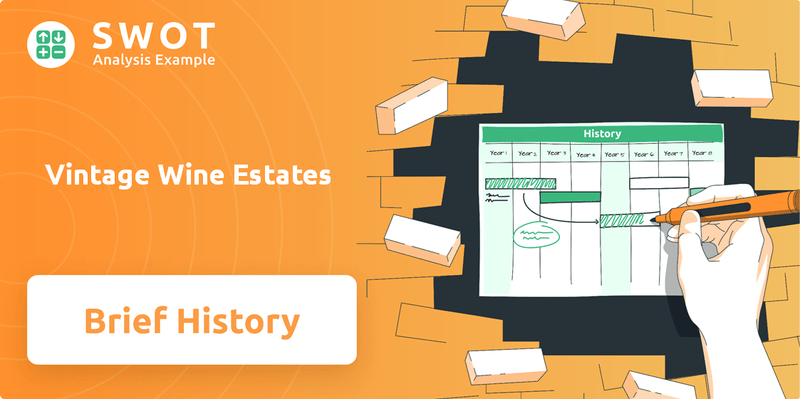
Founded by Pat Roney, Vintage Wine Estates, or VWE, has evolved significantly since its inception. Starting with the acquisition of Girard winery, the company strategically expanded, culminating in the official naming of Vintage Wine Estates in 2007. Today, with a focus on the super-premium to luxury segments, understanding the Vintage Wine Estates SWOT Analysis can provide valuable insights into its strategic positioning and future prospects within the wine estates landscape.
What is the Vintage Wine Estates Founding Story?
The story of Vintage Wine Estates (VWE) began in 2000. Pat Roney, along with a business partner, laid the groundwork by acquiring the Girard winery. This initial acquisition marked the start of what would become a significant player in the wine industry.
The company officially adopted the name Vintage Wine Estates in 2007. This rebranding was a strategic move. It coincided with the acquisition of Windsor Vineyards, a company known for its direct-to-consumer wine sales.
Pat Roney, a wine industry executive, played a critical role in shaping the company's early direction. The initial strategy focused on acquiring and developing established wine brands and vineyards. The goal was to produce high-quality wines and deliver exceptional customer experiences.
Vintage Wine Estates expanded through a combination of brand creation and acquisitions, with over 30 acquisitions since its inception.
- The company's portfolio currently includes around 40 brands.
- These brands range from luxury wines from established wineries to popular lifestyle wines.
- A key early strategy was building an omni-channel sales approach.
- This approach balanced direct-to-consumer (DTC), wholesale, and exclusive brand arrangements.
VWE's approach to the wine market has been multifaceted. The company's strategy includes a focus on a diverse portfolio of brands. This includes both premium and accessible wines. This approach has allowed it to cater to a wide range of consumer preferences and price points. For more insights into the target consumer base, consider reading about the Target Market of Vintage Wine Estates.
The company's early focus on building an omni-channel sales approach proved beneficial. This diversified approach provided a stable platform. It has historically been profitable.
Vintage Wine Estates SWOT Analysis
- Complete SWOT Breakdown
- Fully Customizable
- Editable in Excel & Word
- Professional Formatting
- Investor-Ready Format
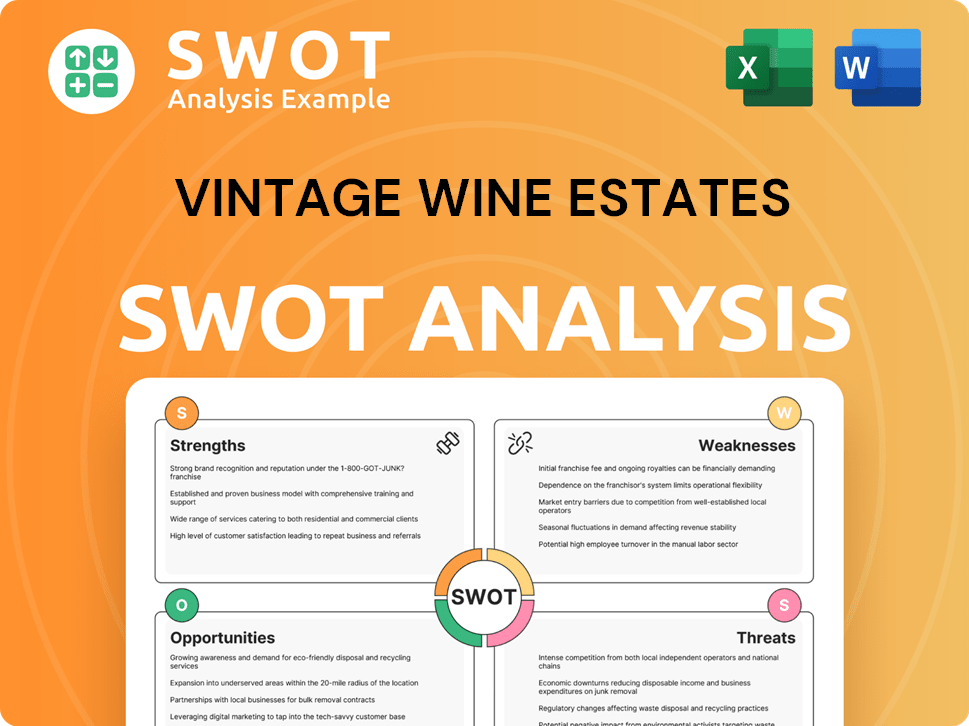
What Drove the Early Growth of Vintage Wine Estates?
The early growth of Vintage Wine Estates (VWE) was marked by strategic acquisitions and organic expansion. After its inception in 2007 with the acquisition of Windsor Vineyards, the company rapidly grew its portfolio. By 2021, VWE had acquired over 20 brands, significantly increasing its market presence in the wine industry.
Vintage Wine Estates expanded its portfolio through numerous acquisitions. By 2021, the company had acquired more than 20 brands, broadening its market reach. This growth strategy helped VWE become a prominent player in the wine estates sector.
In June 2021, VWE went public through a SPAC merger, valued at $690 million. This move provided approximately $306 million in cash, fueling further growth. The company reported a revenue increase of 33% in fiscal year 2022, reaching $294 million.
VWE adopted an omni-channel sales strategy, including direct-to-consumer, wholesale, and B2B channels. As of June 30, 2023, DTC sales accounted for 29.4%, wholesale for 30.6%, and B2B for 40.0%. The company's focus on multiple channels helped it achieve significant market share, positioning it as the 14th largest wine producer.
The company expanded its bottling capacity, aiming for over 13.5 million cases annually. This increase in production capacity supported its growth efforts. For more insights into the company's approach, see Marketing Strategy of Vintage Wine Estates.
Vintage Wine Estates PESTLE Analysis
- Covers All 6 PESTLE Categories
- No Research Needed – Save Hours of Work
- Built by Experts, Trusted by Consultants
- Instant Download, Ready to Use
- 100% Editable, Fully Customizable
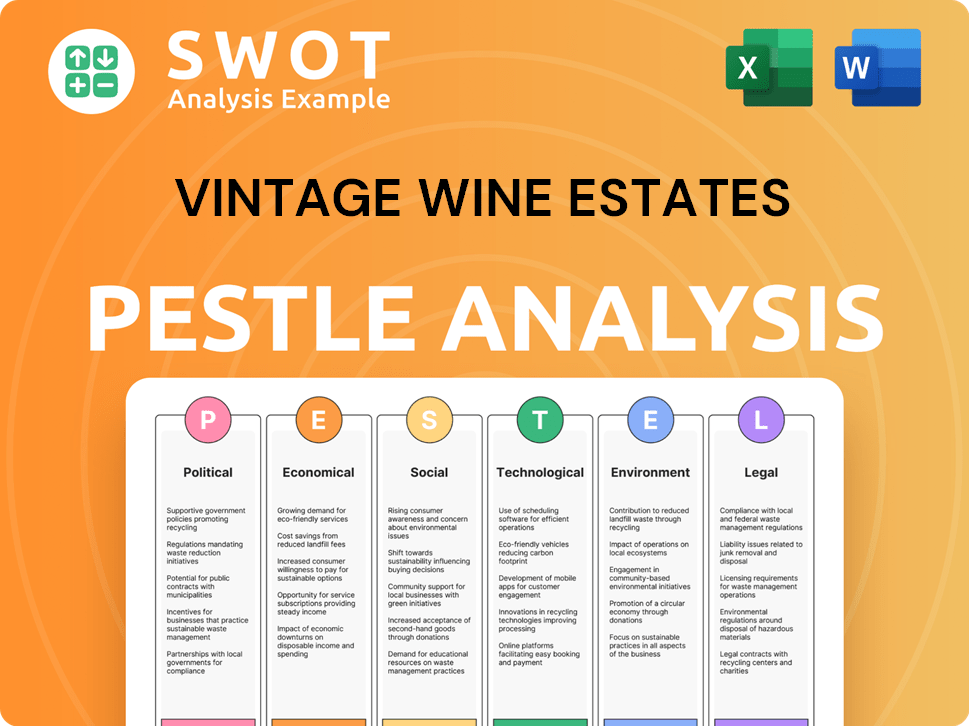
What are the key Milestones in Vintage Wine Estates history?
The history of Vintage Wine Estates (VWE) is marked by significant milestones, including its public debut and strategic initiatives aimed at growth and adaptation. The wine company history reflects a journey of expansion, innovation, and responses to market dynamics within the wine industry.
| Year | Milestone |
|---|---|
| June 2021 | Went public through a merger with Bespoke Capital Acquisition Corp., injecting capital for growth. |
| 2023 | Initiated a 'Five-Point Plan' to address financial challenges, including margin expansion and cost reduction. |
| October 2023 | Seth Kaufman assumed the role of CEO, succeeding Jon Moramarco. |
| March 31, 2024 | Reported a net loss of $138.41 million for the trailing twelve months. |
Vintage Wine Estates has demonstrated innovation through the creation of new brands and expansion into categories like hard cider. Their efficient concept-to-launch process for new products, often completed in less than six months, provided a competitive advantage.
The company has a history of creating new brands to diversify its portfolio and meet evolving consumer preferences. This strategy has been a key part of their growth initiatives.
VWE expanded into new categories, such as hard cider with the ACE Cider brand, to broaden its market reach. This diversification helped to capture different consumer segments.
The company's ability to bring new products to market quickly, often in under six months, has been a significant advantage. This speed allows them to capitalize on market trends rapidly.
Despite its achievements, Vintage Wine Estates has faced challenges, including financial difficulties and the need for strategic restructuring. The company's revenue for the quarter ending March 31, 2024, decreased by 29.37% to $45.67 million, reflecting broader industry trends.
The company initiated a 'Five-Point Plan' to address financial challenges, including efforts to expand margin, reduce costs, manage cash, monetize assets, and grow revenue of key brands. This plan reflects the need for strategic financial management.
VWE announced a restructuring to simplify its business, reducing non-core and lower-margin offerings. This included a reduction of over 50% of SKUs to 2,000, streamlining operations.
The company has seen leadership changes, with Pat Roney transitioning from CEO to Executive Chairman and Seth Kaufman assuming the CEO role in October 2023. This transition has aimed to bring new strategies.
VWE has engaged in asset monetization, including the sale of the Cosentino winery and tasting room for $10.5 million to pay down debt. This strategy helps improve the financial position.
The company's revenue for the quarter ending March 31, 2024, decreased by 29.37% to $45.67 million. This decline reflects broader industry trends and specific challenges faced by the company.
The challenges faced by Vintage Wine Estates are part of broader industry trends, including declining wine consumption volume. This requires strategic adaptation to navigate the market.
Vintage Wine Estates Business Model Canvas
- Complete 9-Block Business Model Canvas
- Effortlessly Communicate Your Business Strategy
- Investor-Ready BMC Format
- 100% Editable and Customizable
- Clear and Structured Layout
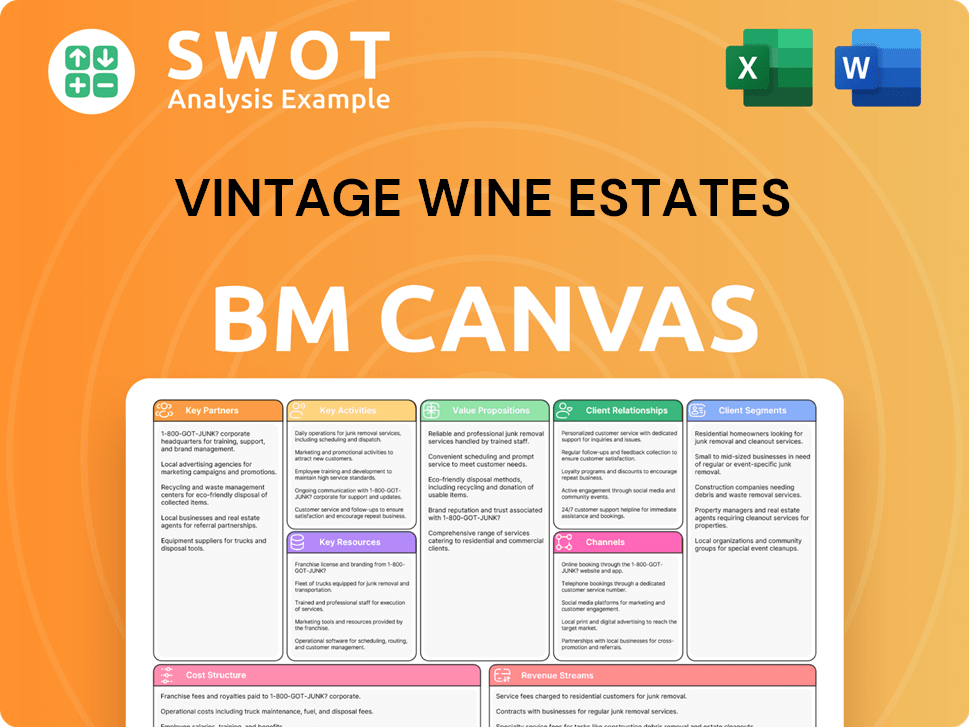
What is the Timeline of Key Events for Vintage Wine Estates?
The history of Vintage Wine Estates (VWE) is marked by strategic acquisitions and financial restructuring. The company, initially founded with the acquisition of Girard winery in 2000, has grown through multiple acquisitions, including Windsor Vineyards in 2007, which officially established Vintage Wine Estates. VWE expanded its portfolio over the years, going public in June 2021. However, the company has faced financial challenges, leading to workforce reductions and a bankruptcy filing in July 2024. Despite these setbacks, VWE has a strategic plan focused on key brands and asset monetization.
| Year | Key Event |
|---|---|
| 2000 | Pat Roney and a business partner acquired Girard winery, starting the company's operations. |
| 2007 | Vintage Wine Estates was officially named with the acquisition of Windsor Vineyards. |
| 2018 | AGR Partners acquired a minority stake in VWE. |
| February 2021 | Wasatch Global Investors acquired a $28 million stake in Vintage Wine Estates. |
| June 2021 | Vintage Wine Estates went public through a business combination, with an enterprise value of $690 million. |
| November 2021 | Acquisition of ACE Cider. |
| January 2022 | Acquisition of Meier's Wine Cellars, Inc. |
| Fiscal Year 2022 | Revenue reached $294 million, up 33%. |
| February 2023 | Pat Roney transitioned to Executive Chairman; Jon Moramarco appointed Interim CEO. |
| March 2023 | Workforce reduction of approximately 20 roles. |
| July 2023 | Seth Kaufman appointed President and CEO, effective no later than October 30, 2023. |
| Q1 Fiscal 2024 | Further reduction in workforce by approximately 25 roles, part of cost-saving initiatives. |
| January 2024 | Announced restructuring to simplify the business and reduce workforce by approximately 15%. |
| March 2024 | Trailing 12-month revenue reported as $249 million. |
| July 2024 | Vintage Wine Estates filed for bankruptcy and announced intention to voluntarily delist from the stock market. |
| Summer 2024 | Foley Family Wines acquired five brands from Vintage Wine Estates in bankruptcy auction. |
The U.S. wine industry is currently facing challenges, including declining overall wine consumption. This requires companies like Vintage Wine Estates to adapt to changing consumer preferences and market dynamics. The Mission, Vision & Core Values of Vintage Wine Estates highlight the company's focus on core strengths.
Vintage Wine Estates is focusing on margin expansion, cost reduction, cash management, asset monetization, and revenue growth. The company plans to simplify its offerings and concentrate on key brands like Bar Dog, Cherry Pie, and Layer Cake. They also aim to monetize assets to reduce debt.
The company is undergoing restructuring and asset monetization efforts to return to a sustainable position. This includes selling assets like the Cosentino winery and focusing on core brands. The goal is to streamline operations and improve financial performance.
The long-term outlook for premium and luxury wine segments is expected to improve in 2025. This will be driven by market normalization and improved consumer sentiment. VWE's success hinges on effective execution of its restructuring plan and adapting to market changes.
Vintage Wine Estates Porter's Five Forces Analysis
- Covers All 5 Competitive Forces in Detail
- Structured for Consultants, Students, and Founders
- 100% Editable in Microsoft Word & Excel
- Instant Digital Download – Use Immediately
- Compatible with Mac & PC – Fully Unlocked
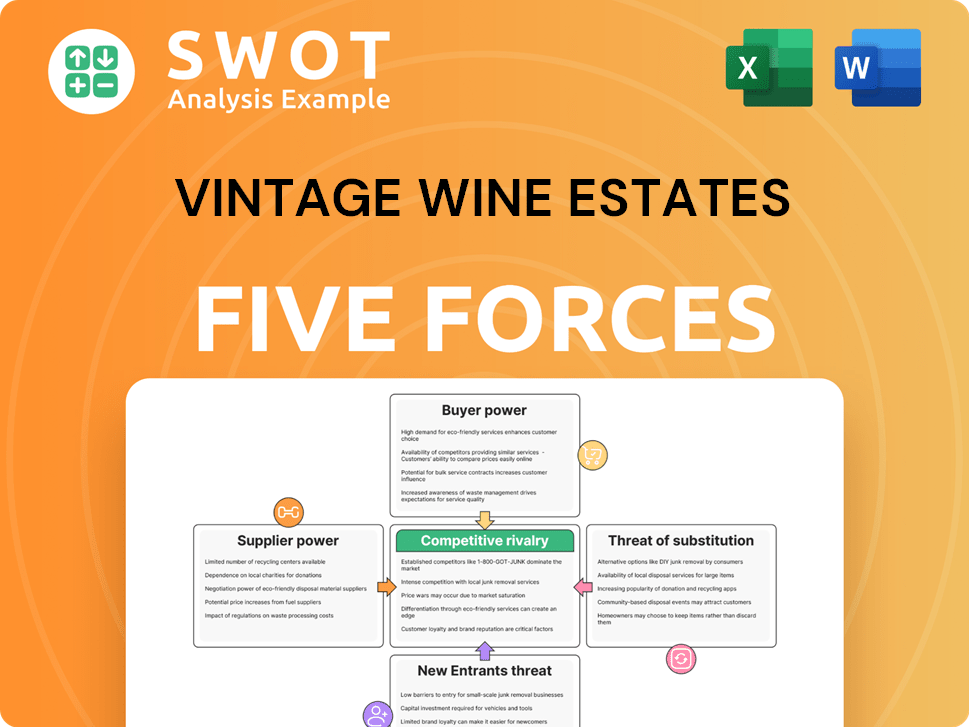
Related Blogs
- What is Competitive Landscape of Vintage Wine Estates Company?
- What is Growth Strategy and Future Prospects of Vintage Wine Estates Company?
- How Does Vintage Wine Estates Company Work?
- What is Sales and Marketing Strategy of Vintage Wine Estates Company?
- What is Brief History of Vintage Wine Estates Company?
- Who Owns Vintage Wine Estates Company?
- What is Customer Demographics and Target Market of Vintage Wine Estates Company?
Disclaimer
All information, articles, and product details provided on this website are for general informational and educational purposes only. We do not claim any ownership over, nor do we intend to infringe upon, any trademarks, copyrights, logos, brand names, or other intellectual property mentioned or depicted on this site. Such intellectual property remains the property of its respective owners, and any references here are made solely for identification or informational purposes, without implying any affiliation, endorsement, or partnership.
We make no representations or warranties, express or implied, regarding the accuracy, completeness, or suitability of any content or products presented. Nothing on this website should be construed as legal, tax, investment, financial, medical, or other professional advice. In addition, no part of this site—including articles or product references—constitutes a solicitation, recommendation, endorsement, advertisement, or offer to buy or sell any securities, franchises, or other financial instruments, particularly in jurisdictions where such activity would be unlawful.
All content is of a general nature and may not address the specific circumstances of any individual or entity. It is not a substitute for professional advice or services. Any actions you take based on the information provided here are strictly at your own risk. You accept full responsibility for any decisions or outcomes arising from your use of this website and agree to release us from any liability in connection with your use of, or reliance upon, the content or products found herein.